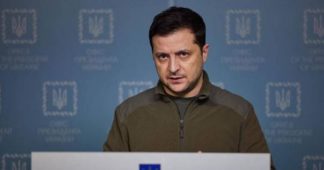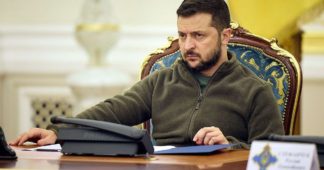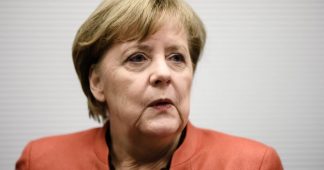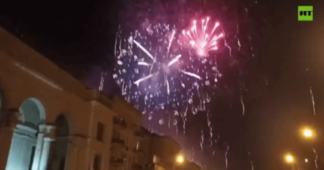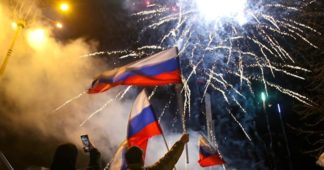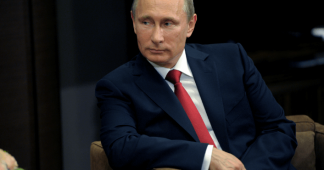By Dmitriy Kovalevich,
special correspondent in Ukraine for New Cold War.org.
Mar 4, 2023
Dmitriy Kovalevich writes a monthly report from Ukraine for New Cold.org. This is his report for February 2023.
As of the end of February 2023, one year has passed since the beginning of Russia’s special military operation (SMO) in Ukraine. The joining of the two Donbass republics of Donetsk and Lugansk to the Russian Federation preceded by several days the launching of the SMO on February 24.
‘Official’ deaths of the peace agreements of 2014 and 2015
By then, the Minsk-2 peace agreement of February 2015 was long dead. The Russian people and the world learned beyond any further doubt that neither the governing regime in Kyiv nor the Western powers backing it ever intended to implement Minsk-2. Most recently, Angela Merkel told this to pranksters who caught her in a prank telephone call late February 2023 (reported here by Deutsche Welle).
Merkel had already acknowledged the same in interviews with several German media outlets at the end of 2022. Minsk-2 was seen by Kyiv and its Western backers as a ‘breathing space’ to further arm Ukraine and prepare it for future conflict with Russia.
The ex-president of Ukraine, Petro Poroshenko (2014-19), as well as the current president, Volodymyr Zelensky, openly boast of their sabotage of the agreement. Both explain away their actions by saying the agreement was disadvantageous to “Ukraine” (meaning the governments they led) and therefore should not be implemented. They boast today that negotiations with Russia were used to buy time to modernize the Ukrainian armed forces. (This is also what Merkel has said, and it has been echoed by another key Western leader of the time, then-French president François Hollande).
The Minsk-2 agreement was signed on February 15, 2015 by the then-government in Kyiv and the pro-autonomy forces in Donetsk and Lugansk. It was co-signed by Russia, Germany and France, acting as ‘guarantors’. The agreement followed the military defeat suffered by ultranationalist paramilitaries and the Ukrainian armed forces of the day at the hands of Donbass self-defense forces.
Russian President Vladimir Putin addressed this shameful episode of modern European history in his annual speech to the Federal Assembly of Russia, on February 21, 2023. Putin emphasized that at the time, the West was also turning a blind eye to paramilitary lawlessness in Ukraine and to the constant shelling of the people of Donbass by far-right Ukrainian paramilitary units.[1]
It is also noteworthy that the beginning of the SMO coincided with the eighth anniversary of the violent overthrow of the then-elected president of Ukraine, in February 2014. He was deposed by rioting ultra-nationalist paramilitaries in Kyiv, backed by the Western embassies in the city. Then, too, a political agreement was reached, this one between leaders of the right-wing protest movement and the elected government. It was aimed at forestalling further violent street protests and was brokered by the European Union and Russia. Police and army personnel were removed from central Kiev as per the agreement, but a violent coup nevertheless ensued, the following day, on February 22.
At the time, the foreign affairs ministers of Germany, France and Poland had co-signed the de-escalation agreement as guarantors. But once then-President Victor Yanukovych had fulfilled his part of the agreement, trusting the words of the Western ministers, the ultranationalists resumed their violent assaults against the government in the center of Kiev. So even back then, one year before Minsk-2, it was becoming clear that the promises and signatures of Western leaders were worth nothing.
The thinking of the pro-Western politicians of Ukraine in 2014 was reflected in comments by the mayor of the city of Dnepropetrovsk, Boris Filatov. He told those in Ukraine [and read here] who were worried by the protests against the coup taking in eastern Ukraine (in Kharkiv, the Donbass republics of Donetsk and Lugansk, Odessa, Crimea and elsewhere), “We must give these bastards some promises now, and we will hang them later.” As it turned out, this also reflected the thinking of leaders of the European Union at the time.
Before the beginning of the SMO, Western media spoke constantly of a “hybrid war” being waged by Russia against Ukraine in Donbass. And the regime in Kyiv has never stopped talking about “Russian aggression” in the region. This is one of the specific features in the consciousness of today’s right-wing, Ukrainian nationalists, namely, the refusal to recognize the civil nature of the conflict that unfolded in Donbass following the 2014 coup.
Russian military strategy
Over the past year, Russian troops have shifted their military tactics several times. In the beginning, there were swift, mobile attacks spearheaded by tanks, often followed by tactical withdrawals. Missile attacks against transport infrastructure began in order to slow the flow of Western arms to the fighting fronts in the east. Attacks on energy infrastructure by Russian missiles and drones began for the same reasons. Since the beginning of 2023, hostilities have abated, mainly due to the successful, methodical destruction of Western military equipment being delivered to Ukraine and also due to the growing manpower shortages of the Armed Forces of Ukraine (AFU).
In February, fighting in and around the small cities of Artemovsk (called ‘Bakhmut’ in Ukraine, pre-war population of 70,000, located some 70 km north of Donetsk city), Kremennaya (pop. 18,000) and Ugledar (pop. 14,000) has continued. The Russian army is gradually moving forward, but at a slow pace to avoid heavy losses of life and property damage in street-by-street or house-to-house fighting.
The offensive by Russia continues, but Ukraine officials are dismissing its significance. According to the deputy chief of the Ukrainian military intelligence service, Vadim Skibitsky, Russia has no strategic vision. He says, “Indeed, they [the Russian offensives] have no strategic nature. There are at least four or five directions in their active military operations in the Lugansk, Donetsk and Zaporozhye regions.” But the Russian army is using the strategy of “a thousand small cuts” in order to exhaust the AFU. This is why there are no grand, visible advances.
The situation in agriculture and utilities
As the sowing season looms in Ukraine’s countryside, agricultural enterprises in all regions are complaining about the shortage of tractor drivers and other machine operators because so many workers have been taken for military service. Due to shortages of workers, fuel and fertilizers, Ukrainian experts predict a 40 per cent drop in wheat and corn yields this year, even if fighting were to suddenly stop.
Similar shortages of skilled workers are being experienced by the country’s utility companies. Hundreds of electricians, mechanics, cleaners and other vital workers have been taken into military service and there is no one to replace them.
The utilities are experiencing an acute shortage of skilled workers because their employees are being conscripted into in the AFU, they are hiding in their homes to evade military service, or they have succeeded in fleeing the country. Current law in Ukraine prohibits any male of the age of military service from leaving the country, and this is strictly enforced along the country’s borders.
Most Ukrainian towns outside of the front lines in the southeast of the country have not been hit particularly hard so far by military hostilities. On the other hand, there is a gradual degradation of infrastructure throughout the country and there is an ever-present danger of its collapse.
“All business in Ukraine is close to being paralyzed,” writes the Ukrainian telegram channel ‘The Skeptic’. “Entrepreneurs are suffering huge losses. Several factors contribute to this, one of which is the shortage of male employees. Men are being taken from the streets by military conscription units and immediately shipped off to the front lines.”
The channel emphasizes that no economic recovery is taking place in real life. The prospect of recovery is only ‘announced’ by Ukrainian authorities from time to time when they decide it is a good moment to again plea to the West for more money.
Daily life in wartime Ukraine
Thanks to a relatively warm winter, the energy situation for ordinary Ukrainians has improved in February. In most regions, shutting off of electricity has diminished and hot water supply has reappeared.[2]
Another issue is that despite relatively low gas and electricity prices (frozen during the current period of martial law), Ukrainians have nonetheless accumulated significant debts owed to utilities. Russia has cancelled such debts in regions that have come under its control and is promising more of the same to other regions that may come under its control in the future.
The price of gas and electricity has been raised for businesses and industrial enterprises, which has led to the closure of many enterprises and, consequently, mass layoffs of workers.
Beginning in February of this year, businesses are required to submit lists of their employees to the military enlistment offices. Male employees then receive notification to appear for military service. To get around the loss of key workers, many companies do not list them as employed.
Significant part of workers in Ukraine since the years of privatizations during the 1990s work unofficially – working part-time or off-site—and are paid in cash. Officially, they are unemployed. This allows a business owner to avoid paying salary-delated taxes and allows workers to avoid paying income taxes. But it also means that workers do not have such rights as joining a trade union, paid vacations or paying into a company’s pension plan. Ukraine’s government has for many years tried to reduce such ‘shadow employment’, but it has returned with a vengeance due to the fear of military conscription.
However, with this form of ’employment’ causes big problems for workers in receiving salaries. An employee can be listed as employed and is therefore subject to army recruitment, or he works without a formal contract and risks not receiving a paycheque or a fair paycheque.
For businesses and industrial enterprises, the prices of gas and electricity have risen, leading to the closure of many enterprises and, consequently, to the dismissal of employees.
Similar problems are experienced by the utility companies. They are experiencing acute shortages of workers due to military conscription or because workers are hiding in their homes to avoid conscription or have fled the country. The hundreds of electricians, mechanics, cleaners and loaders needed to replace them are simply not available.
Most Ukrainian towns, outside the front lines in the southeast of the country, have so far not been hit particularly hard by the military conflict. On the other hand, there is a gradual degradation of infrastructure.
A ‘Ukraine offensive’?
The year since the beginning of the SMO has divided the world even more. On the one hand, there are the Western countries beholden to Washington, willing to forsake their independence and fall into line with it. On the other hand, there are the countries of the global South, most of which are carefully watching the conflict in Ukraine, anxiously awaiting the outcome, and for a host of reasons are unwilling to side with the West.
At the Munich Security Conference in February, Emmanuel Macron admitted that the West has failed to achieve support from many Asian, Africa, and Latin America for its war in Ukraine and its anti-Russian sanctions. He told the conference that he was “shocked by how much credibility we are losing in the Global South.”
Ukrainian politicians and experts are increasingly voicing concerns that the United States is demanding a new ‘offensive’ by Ukraine’s armed forces in order to achieve the ‘turning point’ in the war which which they have been talking about for a year, regardless of the cost in Ukrainian lives. As well, Western support of Ukraine is becoming more and more expensive, and the limits of the military hardware being promised stand exposed. Western media itself is now openly reporting that the promised deliveries by NATO countries of ‘Leopard’ tanks manufactured in Germany are nowhere near as generous as first voiced.
Ukrainian military expert and newspaper columnist Timophei Letov examined the visit by Joe Biden to Kyiv on February 20. He writes, “The Democratic Party needs to finalize the war in Ukraine this year. Ukraine, most likely, has one more chance for a large offensive. After that, an end to the war is more and more needed by the United States.”
He also noted that all eyes should be on China to assess the significance of its forthcoming declaration on the war urging a peaceful resolution(issued on February 24).
Letov added in a harsh column published on March 1, “The armed conflict in Ukraine has no prospect of a peaceful settlement through negotiations. The coming months (as of the coming spring thaw along the front lines) will most likely be a period of bloody battles.”
The armed forces of the Russian Federation have yet to show evidence of launching a large offensive and this makes the Western allies of Ukraine and the general staff of the AFU nervous. They don’t know when, where and if the Russian army will launch large-scale offensives. Russia’s army stages regular maneuvers along the Belarus border with Ukraine—located less than 100 km to Kiev in places—and along the lengthy border between Russian Donbass and Ukraine. Ukraine is thus obliged to keep significant military forces in reserve, away from Donbass, to guard against incursions targeting Kyiv or the cities and regions of Sumy and Kharkiv many hundreds of kilometers east.
Continued media censorship
One year later, all media in Ukraine with a different point of view from the official line remain closed. All television channels are required to broadcast the ‘United News’, telemarathon-style broadcasts where only the official position of the office of the Ukrainian president is aired. For the past year, not a single attempt to reflect upon or explain the conflict has been broadcast in the permitted media.
Official Ukrainian propaganda involves almost exclusively the airing of hysterical emotions by Ukrainian citizens. The country’s opponents are termed “psychopaths” and the causes of the conflict are reduced exclusively to the desires of a single “tyrant”, namely, the president of Russia. The study and practice of political economy in once-renowned schools of political economy in Ukraine has been replaced in such institutions by straight-up, pro-government propaganda.
Ukrainian propaganda for domestic consumption is focused exclusively on the emotional whipping up of its audience. This has led to a sharp fall in viewers and in trust for the television channels because their ‘reporting’ is, frankly, bringing much of the civilian population into states of nervous breakdown. This media promotes hatred of all things Russian. But most Ukrainians speak Russian fluently and many have Russian relatives. Thanks to strict censorship in the media following adoption last year of the Zelensky regime’s ‘Law On the Media’, the share of Ukrainians using television as their main source of news has fallen by 12 per cent. The images and messages on television differ too much from real life.
Tense situation brewing over Moldova
Against the background of the grinding down of the AFU in Donbass and the impossibility of a talked-about, coming ‘offensive’ (being egged on by Western sponsors), theZelensky regime has been escalating tensions in and towards neighboring Moldova.
Moldova (population 2.6 million) is, along with Ukraine, is one of the poorest countries in Europe. Since the beginning of 2023, mass social protests have been taking place there. Thousands of Moldovan residents have taken to the streets demanding financial compensation for escalating bills for natural gas and central heating, which they say are impossible to pay. The pro-Western authorities of Moldova are saying that Russia is stoking the tensions and preparing a coup against the Moldovan government. Zelensky also speaks of this as part of his regime’s efforts to draw Moldova into its war.
The long, narrow strip of land known as Transnistria has been living as a besieged fortress for almost 30 years. It lies exactly between the border of Ukraine and Moldova. There are no mineral deposits nor any significant industry in the small state, which is unrecognized by most of the world. More than half of the inhabitants of this state, some 220,000 people, hold Russian citizenship.
During his visit to Poland on February 22, Biden made a point to meet Moldovan President Maya Sandu. On the same day, the new prime minister of the Moldova Republic again called on the Russian Federation to withdraw its military contingent from Transnistria. There is a small contingent of some 1,500 Russian peacekeeping troops in the territory. Many of them are local residents who hold Russian citizenship and were therefore eligible to join the Russian military or were conscripted. Most have never been to Russia.
In case of a major military intervention by Ukraine and NATO, these peacekeepers could not provide significant resistance. The transfer of military forces from the Russian Federation would only be possible by crossing Ukrainian or Moldovan territory.
Meanwhile, the largest ammunition depot in Europe, preserved from the time of the USSR, is located in the village of Kolbasna some two kilometers from the Ukrainian border. Presently, the Ukrainian army suffers an acute lack of ammunition and Western media is writing that Western arsenals are almost empty and the production of new armaments will take a lot of time. In such a situation, Ukrainian analysts say, the AFU would be able to hold out for another year if it could get its hands on the munitions and weaponry stored in the warehouses of Kolbasna.
In addition, any Russian military and police captured in Transnistria would contribute nicely to a prisoner of war “exchange fund”. Russia currently holds tens of thousands of Ukrainian soldiers as prisoners of war.
There are reports that the Transnistria authorities are mining the warehouses, intending to blow them up in case of invasion by Ukraine with support from the Moldovan government in Chisinau. A demolition on this scale could destroy a significant part of Moldova, Transnistria and the neighboring region of Odessa in Ukraine.
Ukraine media is reporting a concentration of paramilitary forces of Ukrainian ultra ultranationalists in the Odessa region, close to the border with Transnistria. In mid-February, the ‘Battalion of Free Transnistria’ was created. It is named after Dmitry Korchynsky, one of the leaders of the neo-Nazi movement in Ukraine.
In March of last year, Korchynsky opened up to media, saying that President Zelensky has served as very good cover for neo-Nazi paramilitary forces in Ukraine. He told a video broadcast, “Before, I was angry with the Ukrainian people. How could they elect a Jew as president [Zelensky, in 2019]? The president is an important national symbol, just like the national flag and anthem. He should be a Ukrainian! But somehow, it turns out that it is better that the president is a Jew. Try now to present us as being neo-Nazis!” he bragged.
The dangerous situation in Moldova and Transnistria may be the next attempt by NATO and Kyiv to achieve in the shortest possible time their long-awaited ‘turning point’ in the war by drawing new countries in Europe beholden to the West and NATO into the conflict. Neo-colonial Moldova may become an ideal candidate.
Footnotes:
[1] [The English transcript of Vladimir Putin’s address to the Federal Assembly of Russia on February 21, 2023 is here.]
[2] Heating of apartments and other large buildings in Ukraine is supplied by utilities providing hot water or steam directly or by providing natural gas to fire boilers. This is a legacy of the urban planning of Soviet Ukraine. Only small settlements in Ukraine have hot water and heating units (boilers) in individual homes. Residences (apartments) are billed for heating and hot water whether or not a resident is living there. Hence the accumulating debts of those Ukrainians who have left their homes temporarily or permanently to move elsewhere in Ukraine or abroad. Russia has cancelled such debts in regions that have come under its control and is expected to do so in regions that may become so in the future.
We remind our readers that publication of articles on our site does not mean that we agree with what is written. Our policy is to publish anything which we consider of interest, so as to assist our readers in forming their opinions. Sometimes we even publish articles with which we totally disagree, since we believe it is important for our readers to be informed on as wide a spectrum of views as possible.
